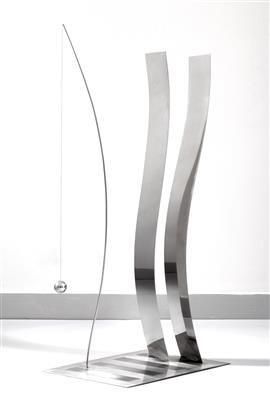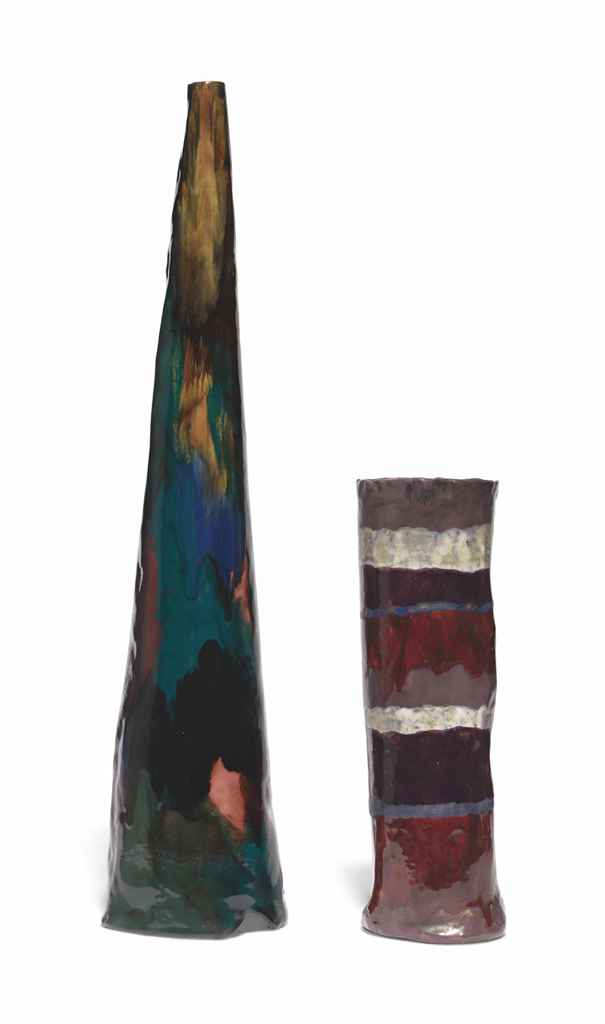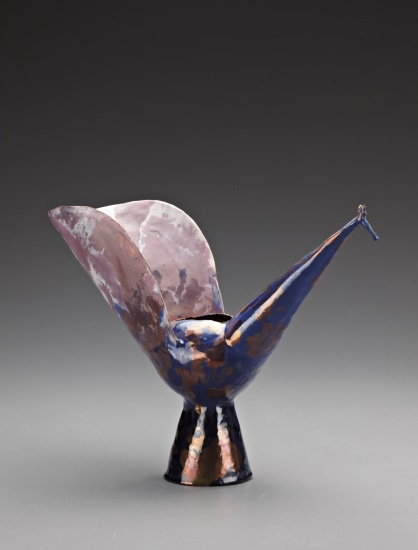Property from a Private Collection Fausto Melotti Follow Female figure signed with the artist's 7 dot cipher on the underside enamelled ceramic height 21.7 cm (8 1/2 in.) Executed circa 1950, this work is registered with the Archivio Fausto Melotti Milan.
Provenance Giorgio Casali, Milan Thence by descent Literature Gian Carlo Bojani, 'Fausto Melotti: delicate folds in ceramics', Keramikos , no. 16, August 1990, n.p. (a similar example illustrated) Germano Celant, Fausto Melotti Catalogo generale, Tomo primo, Sculture 1929-1972 , Milan, 1994, p. 96 (a similar example illustrated) Catalogue Essay Fausto Melotti - Matter and Movement The adventure of the piece of ceramic that enters the oven amorphous and emerges in full party dress is the source of an exciting joy, an indefinite limit between sense and beauty. It’s like a holiday trip into a world that is more fairy-like than magical, a world where expressions like joy in work find value and meaning. That is why I would advise every sculptor to dedicate a bit of time to ceramic now and then ( Fausto Melotti l'incertezza , exh. cat., Nouveau Musée National de Monaco, 2015, p. 18). Alongside contemporaries such as Lucio Fontana with whom he studied at the Accademia di Brera in Milan, Fausto Melotti is considered one the most influential Italian ceramists of his generation. His earliest experience as a ceramist occurred in the late 1920s, when he produced his first decorative pieces in collaboration with the manufacturer Richard Ginori At this time, his friend Gio Ponti played a significant role, ardently supporting Melotti and his ceramic work, as evidenced by the numerous articles published in Domus over the decades. During the post-war period and up until the early 1960s, Melotti worked almost exclusively in ceramic, an accessible material for an artist based in a country still recovering from devastation following the war. He found in the medium a new means of artistic expression and developed a more figurative, humanist language rupturing from the abstract sculptures of the 1930s. This new language was admired by both critics and the public, earning him several awards, including the Gran Prix at the ninth Milan Triennale in 1951. In his studio, located in via Leopardi 26, Milan, he started experimenting extensively with clay, individually producing a considerable number of objects that are as a result entirely unique, in terms of forms, glazes, intrinsic irregularities and iconographies. Of these works there are two main characteristics: the revival of the Archaic and Classical art, which can be seen in the vases, cups, bowls, plates or some figurines, as well as the Baroque inspiration. The latter is exemplified by the feminine figures, depicted in the present work, showing the influence of Gian Lorenzo Bernini in the intricate folds and layers adorning the figure. Executed in the 1950s, this work illustrates Melotti’s experimental approach towards the medium, applying thin-built layers, folded together to create movement and then finished using polychrome glaze. When viewed together with his ceramic production, a more complete portrait of this multifaceted artist emerges, namely one that shows him equally invested in fine art and handcraft, abstraction and figuration, line and volume, fullness and emptiness, colour and form. In 2003, a major exhibition of Melotti’s ceramic work was held at the Museum of Modern and Contemporary Art of Trento and Rovereto, highlighting his distinguished technique and the high quality of the production. Melotti's ceramic works are included in the permanent collections of the Museum of Modern Art, New York, the Museo del Novecento, Milan, and the Galleria Nazionale d’Arte Moderna, Rome. Read More
Property from a Private Collection Fausto Melotti Follow Female figure signed with the artist's 7 dot cipher on the underside enamelled ceramic height 21.7 cm (8 1/2 in.) Executed circa 1950, this work is registered with the Archivio Fausto Melotti Milan.
Provenance Giorgio Casali, Milan Thence by descent Literature Gian Carlo Bojani, 'Fausto Melotti: delicate folds in ceramics', Keramikos , no. 16, August 1990, n.p. (a similar example illustrated) Germano Celant, Fausto Melotti Catalogo generale, Tomo primo, Sculture 1929-1972 , Milan, 1994, p. 96 (a similar example illustrated) Catalogue Essay Fausto Melotti - Matter and Movement The adventure of the piece of ceramic that enters the oven amorphous and emerges in full party dress is the source of an exciting joy, an indefinite limit between sense and beauty. It’s like a holiday trip into a world that is more fairy-like than magical, a world where expressions like joy in work find value and meaning. That is why I would advise every sculptor to dedicate a bit of time to ceramic now and then ( Fausto Melotti l'incertezza , exh. cat., Nouveau Musée National de Monaco, 2015, p. 18). Alongside contemporaries such as Lucio Fontana with whom he studied at the Accademia di Brera in Milan, Fausto Melotti is considered one the most influential Italian ceramists of his generation. His earliest experience as a ceramist occurred in the late 1920s, when he produced his first decorative pieces in collaboration with the manufacturer Richard Ginori At this time, his friend Gio Ponti played a significant role, ardently supporting Melotti and his ceramic work, as evidenced by the numerous articles published in Domus over the decades. During the post-war period and up until the early 1960s, Melotti worked almost exclusively in ceramic, an accessible material for an artist based in a country still recovering from devastation following the war. He found in the medium a new means of artistic expression and developed a more figurative, humanist language rupturing from the abstract sculptures of the 1930s. This new language was admired by both critics and the public, earning him several awards, including the Gran Prix at the ninth Milan Triennale in 1951. In his studio, located in via Leopardi 26, Milan, he started experimenting extensively with clay, individually producing a considerable number of objects that are as a result entirely unique, in terms of forms, glazes, intrinsic irregularities and iconographies. Of these works there are two main characteristics: the revival of the Archaic and Classical art, which can be seen in the vases, cups, bowls, plates or some figurines, as well as the Baroque inspiration. The latter is exemplified by the feminine figures, depicted in the present work, showing the influence of Gian Lorenzo Bernini in the intricate folds and layers adorning the figure. Executed in the 1950s, this work illustrates Melotti’s experimental approach towards the medium, applying thin-built layers, folded together to create movement and then finished using polychrome glaze. When viewed together with his ceramic production, a more complete portrait of this multifaceted artist emerges, namely one that shows him equally invested in fine art and handcraft, abstraction and figuration, line and volume, fullness and emptiness, colour and form. In 2003, a major exhibition of Melotti’s ceramic work was held at the Museum of Modern and Contemporary Art of Trento and Rovereto, highlighting his distinguished technique and the high quality of the production. Melotti's ceramic works are included in the permanent collections of the Museum of Modern Art, New York, the Museo del Novecento, Milan, and the Galleria Nazionale d’Arte Moderna, Rome. Read More



.jpg)







.jpg)

.jpg)

Testen Sie LotSearch und seine Premium-Features 7 Tage - ohne Kosten!
Lassen Sie sich automatisch über neue Objekte in kommenden Auktionen benachrichtigen.
Suchauftrag anlegen